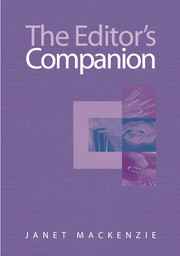Book contents
- Frontmatter
- Contents
- List of illustrations
- Preface
- 1 The editor in context
- 2 The publishing process
- 3 Management and liaison
- 4 Substance and structure
- 5 Language
- 6 Illustrations and tables
- 7 Completeness and consistency
- 8 Proofs
- 9 Editing methods
- 10 Working with documents and files
- 11 Freelance editing
- Appendix: Australian Standards for Editing Practice
- Notes
- Select bibliography
- Index
2 - The publishing process
Published online by Cambridge University Press: 05 June 2012
- Frontmatter
- Contents
- List of illustrations
- Preface
- 1 The editor in context
- 2 The publishing process
- 3 Management and liaison
- 4 Substance and structure
- 5 Language
- 6 Illustrations and tables
- 7 Completeness and consistency
- 8 Proofs
- 9 Editing methods
- 10 Working with documents and files
- 11 Freelance editing
- Appendix: Australian Standards for Editing Practice
- Notes
- Select bibliography
- Index
Summary
In considering types of publication we begin with the book, since that sets the standard and working editors learnt their skills on it.
The book
The printed book is arguably the most successful, durable and significant invention of the last two thousand years. For much of that period it has been the most efficient means for storing and distributing information. Until the advent of electronic communication, there were few alternatives. Broadsheets and songs provided entertainment, public lectures spread knowledge and botanic gardens codified it, but their reach was limited; the book reigned.
The book predates printing. Even if you discount its Chinese antecedents, the Romans were using the codex, or manuscript book, more than fifteen hundred years ago. The church, in the form of monasteries and universities, dominated the early publishing scene; the language was Latin and the content mostly theological. As a literate middle class emerged in the late Middle Ages, demand arose for new types of books: popular works for recreation and technical instruction, generally in a vernacular language. Such books were being commercially published by the fourteenth century. Then Gutenberg introduced moveable type to Europe in the mid-fifteenth century, and the printed book was launched.
The book has been the vehicle for Western thought and civilisation. Authors' names have become shorthand for systems of thought and whole worldviews: Rabelaisian, Macchiavellian, Dickensian, Freudian, Marxist, Orwellian. The best minds have shaped the book, refined and improved it.
- Type
- Chapter
- Information
- The Editor's Companion , pp. 18 - 37Publisher: Cambridge University PressPrint publication year: 2004



